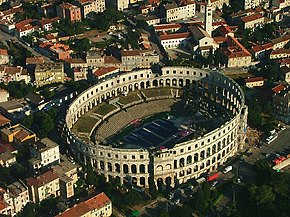Pula Arena

|
|
| Location | Pula, Croatia |
|---|---|
| Type | Roman amphitheatre |
| History | |
| Founded | 27 BC – 68 AD |
| Periods | Roman Empire |
The Pula Arena is the name of the amphitheatre located in Pula, Croatia. The Arena is the only remaining Roman amphitheatre to have four side towers and with all three Roman architectural orders entirely preserved. It was constructed in 27 BC – 68 AD and is among the six largest surviving Roman arenas in the World. A rare example among the 200 Roman surviving amphitheatres, it is also the best preserved ancient monument in Croatia.
The amphitheatre is depicted on the reverse of the Croatian 10 kuna banknote, issued in 1993, 1995, 2001 and 2004.
The exterior wall is constructed in limestone. The part facing the sea consists of three stories, while the other part has only two stories since the amphitheatre was built on a slope. The maximum height of the exterior wall is 29.40 m (96.5 ft). The first two floors have each 72 arches, while the top floor consists of 64 rectangular openings.
The axes of the elliptical amphitheatre are 132.45 and 105.10 m (434.5 and 344.8 ft) long, and the walls stand 32.45 m (106.5 ft) high. It could accommodate 23,000 spectators in the cavea, which had forty steps divided into two meniani. The seats rest directly on the sloping ground; The field for the games, the proper arena, measured 67.95 by 41.65 m (222.9 by 136.6 ft). The field was separated from the public by iron gates.
The arena had a total of 15 gates. A series of underground passageways were built underneath the arena along the main axis from which animals, ludi scenes and fighters could be released; stores and shops were located under the raked seating. The amphitheatre was part of the circuit of the gladiators.
Each of the four towers had two cisterns filled with perfumed water that fed a fountain or could be sprinkled on the spectators. The amphitheatre could be covered with velaria (large sails), protecting the spectators from sun or rain (as attested by rare construction elements).
This amphitheatre, through its remarkable conservation, has served as an excellent example for the study of ancient building techniques.
...
Wikipedia
